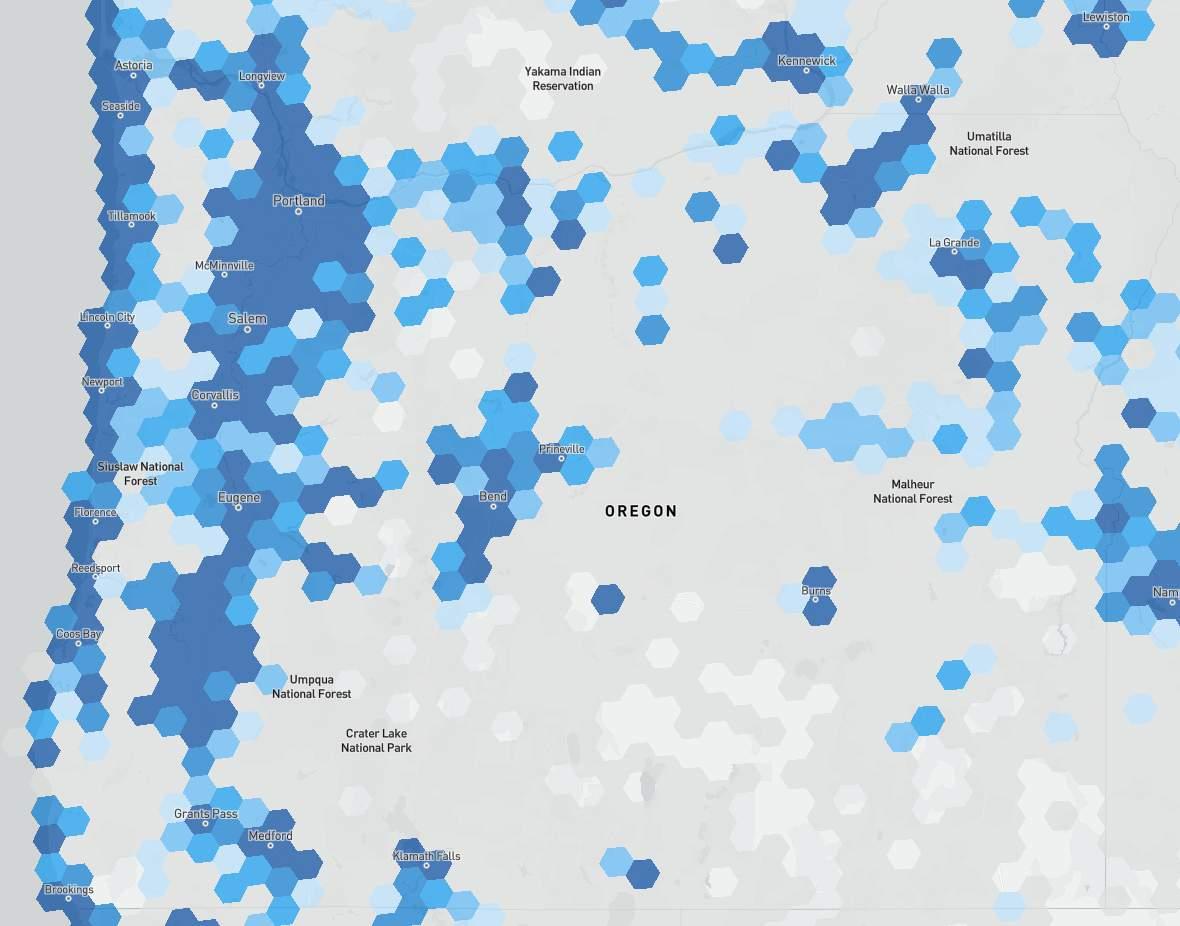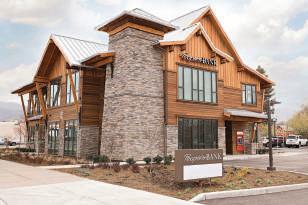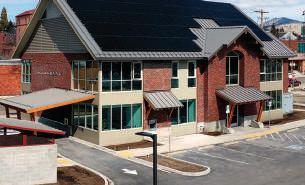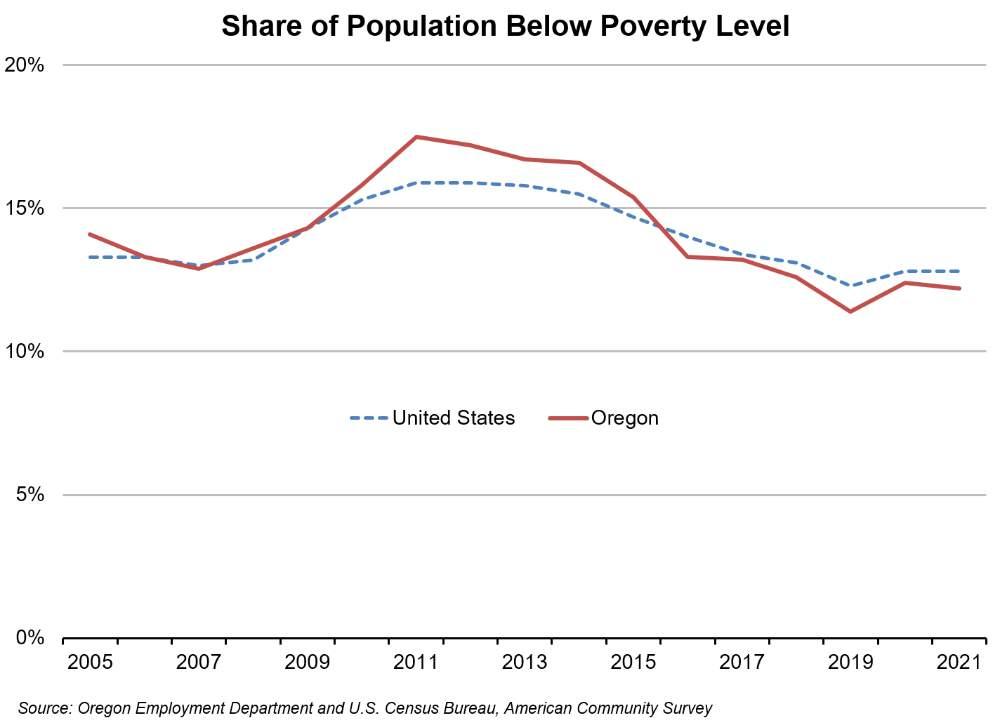Happy New Year?



Medford Mail Tribune Closes. Founded in the 1800’s and only local newspaper to serve a community of 250,000.
Jacksonville Inn Restaurant closes after over 50 years of service. The founders started the business in 1967, sold it in 2021 and it’s now out of business.
Oregon Shakespeare Festival Director leaves, amid restructuring. After only a couple of years on the job, David Schmitz steps down as only the 4th director in OSF’s history.
And were only 2 weeks into the new year
Shocking changes in Southern Oregon to Start the New Year.


January 2023
Serving Benton, Coos, Curry, Deschutes, Douglas, Jackson, Josephine, Klamath, Lane, Lincoln & Linn Counties Since 2015 The Journal for Business in Southern Oregon Sponsored
OREGON GOV. TINA KOTEK TAKES OFFICE WITH A PROMISE TO ‘MAKE THINGS BETTER’ PAGE 8 HOW TO SET OREGON UP FOR SUCCESS IN IMPROVING BROADBAND ACCESS ACROSS THE STATE PAGE 10 HELP US DESIGN THE SOUTHERN OREGON INNOVATION HUB PAGE 37 SouthernOregonBusiness.com
Proudly
by
The Southern Oregon Business Journal extends sincere thanks to









following companies



sponsoring the journal. Without their support we could not produce a FREE resource for Southern Oregon businesses.


Happy New Year.
It’s only the middle of January and so much sad business news has happened already this year, it is overwhelming.
I’m wired to be a positive person. I like to see and report positive things.
But as the deluge of negative press releases and sad news rolled in during the first week of the new year, it made me pause.
Someone sent me an email calling the rapid set of news a “dumpster fire”.
A restaurant closed down. The Jacksonville Inn was loved and ran by its founders for over 50 years. When they wanted to retire they sold it. It’s what you do. One year later it closed its doors. Wow. How does that happen?
The newspaper shut down. Medford is the hub of Southern Oregon and there are over 250,000 people living here. The Mail Tribune has been around in one form or another since the 1800’s. Local news is important. But the internet changed everything. A few months ago they announced they would be digital only and retire the people that worked the presses. And now, it’s gone. How does that happen?
The managing director of the Oregon Shakespeare Festival left amidst a reorganization. He just took the reins a couple of years ago. The festival’s business model hasn’t been able to recover from the impact of the pandemic and it looks like it’s in real trouble. More trouble than any of us knew or thought. When leadership leaves a ship as it’s taking on water, no one is held accountable to guide its recovery and focused on getting it back on a new sustainable path? How does that happen?
It’s going to be an interesting year. The zombie mode that the PPP and EIDL loans created to save companies from the pandemic will now start to show the delayed effect of death. Business owners looking to retire will sell their businesses to smart business people with money and ideas to grow the business they just bought, but will they have the entrepreneurial spirit required to work for free during hard times or is it just cheaper to shut it down.
Large art organizations that bolstered the local economy with tourism before the pandemic, failed to realize that everything is going to be different and change is hard but necessary to survive. There is no going back to how it used to be.
Other sources of local news exist and more will pop up to fill the void. I got involved with the journal when I realized how much local business news wasn’t being reported. I helped fill that void that was created a couple of years ago. It’s what happen.
Like I said, I’m an optimist. It may be a dumpster fire right now, but if you don’t get too close you can use the heat it throws off to stay warm and survive until spring.
AMERITITLE - PAGE 4
PEOPLE’S BANK - PAGE 18
MANAGED HOME NET - PAGE 19
SOU - LEADERSHIP BEGINS HERE SOUTHERN OREGON UNIVERSITYPAGE 24
PROJECT A - PAGE 35
| Southern Oregon Business Journal January 2023 2 A Few Words from Jim January 2023
Jim Jim@SouthernOregonBusiness.com
the
for
Founder Greg Henderson ghenderson703@gmail.com Greg started the Southern Oregon Business Journal in 2015 and retired in 2020. PLEASE SUPPORT OUR ADVERTISERS
2023 Dumpster Fire
Photo by Stephen Radford on Unsplash
5350 HWY 66, Ashland, Oregon 97520 www.SouthernOregonBusiness.com
A JOURNAL FOR THE ECONOMICALLY CURIOUS, PROFESSIONALLY INSPIRED AND ACUTELY MOTIVATED
JANUARY 2023 - TABLE OF CONTENTS
Southern Oregon Business News

Dutch Bros Inc. Reports Preliminary Fourth Quarter and Fiscal Year 2022 New Shop Openings and Same Shop Sales Results - 5
Is Valley View Winery For Sale? - 6
Audit: Oregon broadband office not prepared for federal infrastructure grants - 7
Oregon Gov. Tina Kotek takes office with a promise to ‘make things better’ - 8
How to Set Oregon Up for Success in Improving Broadband Access Across the State - 10
Rural Oregon Cities Receive Business Oregon Community Development Block Grants - 12
Business Oregon Awards Funding for Innovation Projects in Business and Industry - 14
Grant Applications Open to Organizations Advancing Economic Equity - 16
Poverty and the Oregon Workforce - 20
SOU alumnus and Foundation Board member inducted into inventors’ academy - 25
SOU receives solar support from Congress - 26
SBDC : Innovators and Creators - 28
8 Billion and Counting - A fine line by Greg Henderson - 30
Finding the Best: Unique Perspectives - 32
Help us DESIGN the Southern Oregon Innovation Hub - Take a survey - 37
Oregon Shakespeare Festival Announces Leadership Departures, Staff Changes, And Revitalization
Strategy Amid Post-Pandemic Recovery - 38

LOCAL PUBLIC COMPANIES
By Press Release https://investors.dutchbros.com/news
Dutch Bros Inc. Reports Preliminary Fourth Quarter and Fiscal Year 2022 New Shop Openings and Same Shop Sales Results
GRANTS PASS, Ore.--(BUSINESS WIRE)-- Dutch Bros Inc. (NYSE: BROS; the “Company”) one of the fastestgrowing brands in the food service and restaurant industry in the United States by location count, today reported preliminary highlights for the quarterly and annual periods ended December 31, 20221. The Company also released revenue guidance for 2023, issued long-term growth targets and announced its participation at the 25th Annual ICR Conference and 12th Annual Jefferies Winter Restaurant, Foodservice, Gaming, Lodging & Leisure Summit.
Joth Ricci, Chief Executive Officer and President of Dutch Bros Inc., stated, “In 2022, we delivered another strong year of growth with 133 new shop openings systemwide.1 That growth is a testament to our team’s ongoing ability to execute on our proven growth strategy. For a third year in a row, we’ve exceeded our new shop development targets, doubling our shop count since March 2019, despite unprecedented disruption to communities and the economy. As we continue on our 30+ year growth journey, we’re entering 2023 from a position of strength, supported by a robust new unit pipeline, building market share in existing markets and growing our people systems.”
He continued, “In 2023, we’re targeting 150 new shops, which positions us to achieve our five-year goal of 800 systemwide shops by year-end. Additionally, we’re within striking distance of $1 billion in
revenue in 2023 and 1,000 systemwide shops by the first half of 2025, creating jobs and opportunities for our employees and the communities in which we serve.”
Preliminary Fourth Quarter 2022 Highlights1:
Opened 30 new shops, of which 26 were company-operated.
System same shop sales2 declined (0.6)%, inclusive of the impact of our fortressing strategy, which results in sales being transferred from existing shops to new ones, as compared to the same period of 2021 and grew 15.2% on a 3-year stacked basis3.
Company-operated same shop sales2 declined (2.1)%, inclusive of the impact of our fortressing strategy, as compared to the same period of 2021 and grew 16.2% on a three-year stacked basis3.
Preliminary Full Year 2022 Highlights1:
Opened 133 new shops, of which 120 were company-operated.
System same shop sales2 grew 1.0%, inclusive of the impact of our fortressing strategy, which results in sales being transferred from existing shops to new ones, as compared to the same period of 2021 and grew 11.4% on a three-year stacked basis3. Company-operated same shop sales2 grew 0.6%, inclusive of the impact of our fortressing strategy, as compared to the same period of
2021 and grew 10.4% on a three-year stacked basis3.
As of December 31, 2022, the Dutch Bros system consisted of 671 shops (396 company-operated and 275 franchised-operated) across 14 states1
Preliminary Fiscal Year 2023 Outlook
For full year 2023, Dutch Bros is providing the following preliminary outlook:
Total system shop openings are expected to be at least 150, of which at least 110 shops will be companyoperated.
Total revenues are projected to be in the range of $950 million to $1 billion.
Same shop sales2 growth is estimated in the low single digits.

Long-Term Growth Targets
Looking beyond 2023, Dutch Bros is providing the following long-term growth targets over the next five to ten years.
3
1
2
Southern Oregon Business Journal January 2023 | 5
Historical amounts presented within this press release are preliminary, unaudited, and subject to ongoing accounting controls and procedures.
Same shop sales growth reflects the change in year-over-year sales for the comparable shop base, which we define as shops open for 15 complete months or longer. Management uses this metric as an indicator of shop growth and future expansion strategy. The number of shops included in the systemwide and company-operated comparable bases are presented in the following table as of the respective dates.
3-Year Stack is calculated as current quarter same shop sales growth plus the sum of the same shop sales growth from the same period of the prior two years. Same shop sales data is based on different shop bases for each time period.
AGRICULTURE
By LoopNet Post
https://www.loopnet.com/Listing/1140-UpperApplegate-Rd-Jacksonville-OR/27178849/
Last month we featured the social post of Valley View Winery celebrating 50 years of business and proclaiming they will never be for sale. A cool story about family farms that live on for generations. A few days later someone sent me a listing on LoopNet for 1140 Upper Applegate Rd - Valley View Winery Land, Buildings, Homesite. I’m presenting here and reached out for more info, still waiting reply. https://www.loopnet.com/Listing/ 1140-Upper-Applegate-RdJacksonville-OR/27178849/
INVESTMENT HIGHLIGHTS
One of the oldest wineries and vineyards in Oregon, 35 Acres of Vineyard/Tasting Room/Winery/ Warehouse/Barn, M37/49 Approved Homesite

Holds an Oregon Hemp License EXECUTIVE SUMMARY


Is Valley View Winery For Sale?
FOR SALE?
**Own a piece of history, the home of one of Oregon's first wineries, Valley View Winery and Vineyards. This property is owned by the venerable matriarch, 90-year-old Ann Wisnovsky, who purchased the land with her husband Frank, and created a vineyard, winery and a Southern Oregon Legacy. Ann and Frank were modern-day pioneers, planting grapes where no one thought it could be done, and succeeding. Few can boast the accomplishments that this amazing woman has achieved, and you can be a part of her story when you purchase this amazing property. Site your new home in the center of this active winery, and experience country living at its finest. Ann's remarkable story has inspired an industry, as she took over the operations of the winery after her husband's tragic death in 1980 and single handedly grew it to a successful, thriving business until her eldest son, Robert, returned from
college to join her at the helm. Appraisal available on request. Approximately 74 acres, includes winery building, tasting room, warehouse, barn, 35 acres of grapes, and an approved measure 37/49 homesite and a hemp license.
PROPERTY FACTS
Price $4,800,000
Building Class B Price Per SF $2,373
Lot Size 74.00 AC
Sale Type Investment or Owner User Building Size 2,023 SF
Sale Conditions Ground Lease (Leasehold) No. Stories 1
Property Type Specialty Year Built 1950
Property Subtype Winery/Vineyard Listing ID: 27178849
Date Created: 11/23/2022
Last Updated: 12/14/2022
Address: 1140 Upper Applegate Rd, Jacksonville, OR
Joanne Wisnovsky Couvrette Wisnovsky Land, LLC (619) 750-8509
13274 Jacarte Ct San Diego, CA 92130
| Southern Oregon Business Journal January 2023 6
BY: JULIA SHUMWAY Oregon Capital Chronicle
https://oregoncapitalchronicle.com/2023/01/12/audit-oregon-broadbandoffice-not-prepared-for-federal-infrastructure-grants/
Oregon’s broadband office doesn’t have the staff or plans it needs to take advantage of up to $1 billion in federal money to expand internet access, according to an audit released Wednesday.
The report from the Audits Division of the Secretary of State’s Office found that the state has work to do to effectively allocate money and help Oregonians get online. The state stands to receive between $400 million and $1 billion in federal funds for broadband under the $1 trillion bipartisan infrastructure law passed in 2021.
“Both the Legislature and the department have taken action, we’re staffing up, we’re getting there, but we are behind and we’ve had some significant consequences because of that,” said Kip Memmott, the state audits director.
Former Gov. Kate Brown created the Broadband Office within Business Oregon in 2018 with a single employee, and the office didn’t add more employees until early 2022. It now has 12 positions, though not all are filled. Auditors urged the office to add staff to administer federal grants.
A pre-pandemic 2020 study found that an estimated 1.7
Audit: Oregon broadband office not prepared for federal infrastructure grants
million Oregonians lived in areas without broadband connections or with outdated basic services that were insufficient to meet current demands.
Rural areas and tribal lands are less likely to have access to broadband than urban areas, largely because of environmental factors that make building infrastructure more expensive. For instance, the audit found that it costs close to $55 per foot to lay fiber in the 644,000 acres of buttes, canyons, forests and rocky land of the Confederated Tribes of Warm Springs, but only $5 per foot in the Willamette Valley, where soil is softer and easy to dig.
“It will likely take innovative solutions, such as giving appropriate due deference to tribal grant applications, allowing in-kind services in exchange for providing up-front capital for infrastructure, and other nontraditional approaches that respect tribal sovereignty and traditions, while providing affordable internet service to the Tribal communities in Oregon,” the audit said.
Access also differs across racial and economic lines. The audit found that fewer than half of Oregon households in the lowest income quintile use the internet at home, compared to 95% of households in the top quintile.
And the audit cited national research that showed white adults have significantly higher access to broadband and home computers than Black or Hispanic adults.
The rise of remote work and school, as well as internetdependent services such as telehealth appointments, exacerbated the existing digital divide after the pandemic struck.
And the audit found that the state doesn’t have a clear picture of coverage gaps.
A map produced by the office using data from the Federal Communications Commission shows that census blocks are considered covered if a single home in the block can get coverage. Census blocks can stretch for miles in rural areas, and areas aren’t eligible for federal assistance if the map shows that they have broadband coverage.
“Without an accurate picture of Oregon’s current broadband infrastructure deployment and utilization status, it is difficult for the Broadband Office to identify the areas in most need of service and strategically target its efforts,” the report said.
Southern Oregon Business Journal January 2023 | 7 BROADBAND
BY: JULIA SHUMWAY
Oregon Capital Chronicle
https://oregoncapitalchronicle.com/2023/01/09/oregon-govtina-kotek-takes-office-with-a-promise-to-make-things-better/
Oregon Gov. Tina Kotek takes office with a promise to ‘make things better’
As she took office as governor Monday, Tina Kotek promised to wake up every day with a mission: to take on Oregon’s biggest challenges and make things better.

“It’s a simple idea – making things better –but as we all know, a difficult thing to achieve,” she told members of the Oregon House and Senate and other state officials in a joint legislative session on Monday afternoon.
That starts with a recognition that the status quo isn’t working, Kotek said. And it requires working together toward a vision of an
Oregon where no one lives in a tent on a sidewalk, where every child has access to a high-quality public education and where everyone feels safe in their homes and communities, she said.
“That’s an Oregon worth fighting for – and today is a new beginning,” Kotek said. “I’m eager to get to work. And I hope you will join me.”
Monday marked the beginning of a new era in state government, with Kotek, new Senate President Rob Wagner and nearly one-third
from : https://www.oregon.gov/gov/Pages/index.aspx
of the 90-member Legislature beginning new jobs. Her address to a joint legislative session was the first time since before the pandemic began in 2020 that legislators gathered en masses and largely unmasked. But because of an ongoing construction project that has closed much of the Capitol, Kotek addressed a relatively small group of government officials and reporters instead of the hundreds of people who normally would pack galleries ringing the House chamber. Construction workers agreed to pause their jackhammering during the inauguration itself, but the clang of tools
| Southern Oregon Business Journal January 2023 8
POLITICS
Photo
punctuated earlier meetings of the House and Senate.
“Today is a new beginning. I’m eager to get to work. And I hope you will join me.” – Gov. Tina Kotek
Kotek, a Democrat like her predecessor, Kate Brown, faces immense challenges as she takes office as Oregon’s 39th governor. Thousands of Oregonians are living on the streets or sleeping in shelters or on other people’s couches, and many more struggle to afford their rent or mortgage payments. Oregon’s addiction rate is among the highest in the nation.
And more Oregonians voted for a candidate other than Kotek than voted for her in the November election. Kotek succeeds a historically unpopular governor, and she said connecting with Oregonians with shared concerns and different opinions is a top priority.
Kotek said she has drawn inspiration from a surprising place: Vic Atiyeh, the last Republican governor of Oregon who left office in the 1980s.
The two may come from different parties, she said, but they were both former legislators with budget experience and both made history as “firsts” – Atiyeh as the nation’s first elected governor of Arab descent and Kotek as the nation’s first openly lesbian governor, a distinction she shares with new Massachusetts Gov. Maura Healey. Kotek’s wife, social worker Aimee Kotek Wilson, stood by her side as she took her oath.
Kotek quoted Atiyeh’s inaugural address, in which he promised to continue listening to all Oregonians, not just those with the means to press their cases in Salem. And she repeated an Atiyeh pledge to visit every county, an initiative Kotek began with a trip to Yamhill County just before Christmas.
One of her first actions on Tuesday, her first full day in office, will be to sign an executive order establishing a statewide goal of building 36,000 new homes per year. Oregon needs to add roughly 550,000 homes over the next 20 years to meet current and expected housing needs, according to the state Department of Land Conservation and Development. The state has averaged only about 20,000 homes per year in recent years.
“Building more housing is key to creating healthier and safer communities and supporting economic growth,” Kotek said. “I look forward to bringing comprehensive recommendations to this body as soon as possible.”
She’ll also declare a state of emergency for homelessness, an action that would give Kotek greater authority to address the state’s ongoing homelessness crisis. A citywide homelessness state of emergency declared in Portland several years ago reduced bureaucratic barriers around zoning and building shelters.
“I look forward to building on this emergency investment with a comprehensive housing and homelessness package by the end of this session.”
– Gov. Tina Kotek
And Kotek said she will ask the Legislature to quickly approve a $130 million spending package aimed at expanding shelter space and helping at least 1,200 homeless Oregonians move off the streets in the next year.
“I am urging you, as leaders, to start the legislative session by taking up this investment package as quickly as possible,” she said. “And believe me, this is only the first step. I look forward to building on this emergency investment with a comprehensive housing and homelessness package by the end of this session.”
House Speaker Dan Rayfield, D-Corvallis, who was elected to his first full term earlier Monday, said in his own speech to lawmakers that he expects to pass a housing funding package within the first 60 days of the session, which begins Jan. 17. He didn’t provide details.
Another big goal is accountability, Kotek said. She has already made changes at several troubled state agencies, including replacing the director of the Oregon Health Authority and appointing a new state behavioral health director. Last week, Kotek also announced that the director of the Oregon Department of Education will leave at the end of June.
Director Colt Gill has come under fire as Oregon students lag their peers in other states in core areas including reading.
Kotek said she will deliver a new set of expectations to the leaders of every state agency by the end of the week. And she said she will direct agency leaders to modernize systems to make the government work better for Oregonians. Outdated computer systems and bureaucratic barriers make it difficult for Oregonians to accomplish simple tasks like apply for building permits, receive employment assistance or use other government services.
“When your community or your family is facing a crisis, our job is to provide the tools that you need — not barriers that make things harder,” she said. “As we address the very large, complex challenges our state faces — whether it’s housing, behavioral health, or education — we have to put our own house in order too.”
Kotek said she and her team will spend Saturday participating in a community cleanup to mark the service of Martin Luther King Jr., whose life is celebrated Monday. She urged other Oregonians to do volunteer work of their own.
“It will take all of us, doing what we can, to build the Oregon we want to live in,” she said.
Southern Oregon Business Journal January 2023 | 9
By Oregon Broadband Office https://www.oregon.gov/biz/programs/Oregon_Broadband_Office/Pages/ Broadband_Map.aspx
How to Set Oregon Up for Success in Improving Broadband Access Across the State
The FCC Launched a National Broadband Map that shows addresses across the U.S. and the quality of internet access for each, with information provided by service providers. Knowing where broadband is available (and more importantly, where it is not) is critical to secure funding and
improve broadband access for our underserved communities.
We need everyone’s help to make sure the FCC has the most accurate picture of what we need in Oregon. The following walks through the process to check your
address and challenge the data if it shows you have better access than you actually do.
An accurate broadband map will help identify the communities most in need of funding for high-speed

| Southern Oregon Business Journal January 2023 10 BROADBAND
internet projects and will be used by the National Telecommunications and Information Administration (NTIA) to determine how much federal BEAD funding each state receives. We have until only January 13 to update the map.
What is the FCC National Broadband Map?
The National Broadband Map displays address-specific locations of where internet services are (and are not) available nationwide, as reported by internet service providers. The map allows consumers and other stakeholders to dispute or challenge information shown on the map that they believe is inaccurate. To view the map, visit BroadbandMap.FCC.gov
• The Fixed Broadband Map shows the fiber, cable, DSL, satellite, or fixed wireless internet services available at each home or small business on the map. When you search for an address and select a location on the map, you can see which providers report offering broadband service at that location, as well as the technologies and maximum advertised
download and upload speeds they each offer.
• The Mobile Broadband Map shows the provider-reported 3G, 4G, and 5G coverage of each mobile provider for the area displayed. The coverage areas reflect where consumers should be able to connect to the mobile network when outdoors or in a moving vehicle, but not necessarily indoors. The map allows you to compare mobile wireless coverage reported by different mobile providers.
NOTE: Individual location points appear on the map if you search for a location or zoom in. These points identify buildings or structures – such as a home, apartment building, or small business –where internet services are, or could become, available. Each location is part of a dataset called the Broadband Serviceable Location Fabric. Gray location points represent buildings or structures that are not likely to use mass-market broadband services.
The FCC and the State of Oregon are working hard to provide you with resources to complete successful challenges. The following
sections provide links to resources:
• Click here to view the FCC National Broadband Map.
• Click here to learn how government entities can participate in the Broadband Data Collection.
• Click here to watch The Fixed Service Availability Data Challenge Process & Implications for Internet for All.
• Click here to learn how to submit an Availability Challenge.
• Click here to learn how to submit a Mobile Challenge
• Click here to learn how to submit a Location Challenge .
• Click here for Business Oregon's FCC Broadband Map twopager and here for the Business Oregon FCC Broadband Map flyer in multiple languages .
Southern Oregon Business Journal January 2023 | 11
By Business Oregon Press Release https://development.oregon4biz.com/acton/rif/14786/s-060a-2211/-/
Rural Oregon Cities Receive Business Oregon Community Development Block Grants

Business Oregon is supporting eight city projects statewide through the Community Development Block Grant (CDBG) program. The CDBG program supports the development of livable communities by expanding economic opportunities and providing suitable housing and living environments for persons of low and moderate income. These eight grants total $10,582,401 and assist rural communities with funding for important projects around the state.
Business Oregon administers the state of Oregon's annual federal allocation of CDBG
funds for non-metropolitan cities and counties. Tribes and urban cities and counties are not included in the state's program as they receive CDBG funds directly from the U.S. Department of Housing and Urban Development.
Recipients in this round of funding:
City of Burns: The City of Burns’ Residential Housing Rehabilitation Type 2 grant will provide needed funding for up to 20 low to moderate income families. The funding will be used to alleviate substandard conditions and provide affordable, decent, safe, and sanitary housing for
homeowners in Burns, Hines, and elsewhere in Harney County. The funding will be used for needed repairs and upgrades, energy efficient measures, and addressing health and safety issues.
City of Independence: The City of Independence was awarded CDBG funding to utilize a housing rehabilitation program that will provide home repairs to owner-occupied, low to moderate income households within Independence and the Polk Regional Collaborative (PRC) service area. In partnership with other PRC members, this program could assist as many as 30 eligible
| Southern Oregon Business Journal January 2023 12 BUSINESS OREGON
l-0007:4d5c/l-0007/showPreparedMessage?sid=TV2:Bcbgii4gr
Photo by Stephen Leonardi on Unsplash
households who have no other access to home improvement resources or related financing opportunities. This program provides the opportunity to support household health and safety while also preserving needed housing stock in the PRC service area. Grant funds will be awarded to eligible applicants for making home repairs essential to preserving the structural and service integrity of each home in support of household health and safety.
City of Falls City: Falls City currently operates a Septic Tank Effluent Pumping (STEP) system with the drain field located under the Falls City High School football field. The city has experienced wastewater on the football field requiring the city to close the field. The current drain system was installed in the 1980s and needs to be replaced. Falls City is replacing the current recirculating UV gravel filter and drain field treatment with lagoon storage/ treatment facility. The CDBG funding will finance construction on the new wastewater treatment plant.
City of Willamina: The City of Willamina's intake infrastructure is failing due to an eroding riverbank upstream which dumps silt into the city's system. The silt causes damage to the system and reduces or stops the city's ability to provide its
community with water. In addition, there is a gravel bar that is migrating and has already begun to land on the intake structure. The engineers have advised that the intake will fail within the next two to three years. The long-term water intake improvements include moving the intake to a new location, which will block the migrating gravel bar and is a self-scouring basalt bedrock, which will alleviate the silt fouling the system. The city’s award will be partnered with other secured funding to complete the construction of a new water intake system.
City of Umatilla: The City of Umatilla owns and operates a public water system. The city intends to use their funding to extend water service to Power City and construct a new, compliant, and reliable water distribution system to service the residents of the Power City and Brownell communities (areas located within the City's Urban Growth Boundary).
City of Sumpter: The city of Sumpter owns a main drinking water contact tank which is in immediate need of replacement. The tank is made of wood, and damage from woodpeckers and natural deterioration have created leaks in the tank. The structural integrity of the tank is compromised and losing the tank would leave the town without drinking water. The city’s
water infrastructure is already on the verge of failure, so the increased demand has pushed the city’s system to the brink. The CDBG funding will support the construction of the new water tank.
City of Coquille: The city has identified deficiencies in their water distribution and supply systems due to the antiquated undersized distribution lines that are riddled with cracks and leaks due to the increased pressure of the water tower. Water supply improvements are needed to ensure reliability of operations.
The CDBG funding will support the planning and design of the Coquille Water System improvements.
City of Sheridan: The city's sanitary sewer system experiences high stormwater influx during the wet season, which can result in emergency, unpermitted discharges from the wastewater treatment plant during extreme weather events. The CDBG funding will support completion of the final design and environmental assessment documents to conduct sewer system improvements.
More information on each of these projects, as well as full program information, is available at Oregon.gov/biz/ programs/CDBG.
Southern Oregon Business Journal January 2023 | 13
By Business Oregon Press Release
https://development.oregon4biz.com/acton/rif/14786/s-060d-2211/-/ l-0007:4d5c/q-000c/showPreparedMessage?sid=TV2:cBYMAomf8
Business Oregon Awards Funding for Innovation Projects in Business and Industry
Business Oregon and the Oregon Innovation Council (Oregon InC) is awarding nearly $1 million in a new round of funding to support innovation in Oregon. Eleven recipients will receive awards from two grant programs, the High Impact Opportunity Projects (HIOP) and Small Business Innovation Research (SBIR) matching grants.
“Business Oregon, through Oregon InC, is pleased to award nearly $1 million in investments to Oregon businesses and projects focusing on innovation. We are optimistic that these funds will catalyze new innovations and give Oregonbased companies and teams a competitive advantage as they commercialize their ideas and products,” said Kate Sinner, Innovation and Entrepreneurship Manager at Business Oregon.
The HIOP program supports the growth of emerging, high-value
industry sectors by providing competitive grants to remove barriers to research and development, advance product development and testing, and commercialize technology. Grants are awarded to organizations and consortiums for projects that benefit industrywide innovation.
SBIR is a federal grant program for small businesses designed to stimulate technological innovation and provide opportunities for small businesses to conduct research and development with commercialization potential. SBIR Matching Grants are designed to complement the federal SBIR program by filling gaps where the federal funding cannot be used. Seven companies were awarded Phase I matching grants and two companies were awarded Phase II matching grants.
Applications were solicited separately for both programs, and after multiple stages of review, the following companies and organizations have been selected to receive grant awards.

HIOP Awards
McMinnville Economic Dev. Partnership, $241,936: A consortium that includes Oregon State University, municipalities, industry partners, and two trade associations will conduct lab testing and development of concrete formulas intended to reduce the climate impact of carbon. They will research, test, and pilot open-source concrete formulas and publish a toolkit and case study that highlights how the industry can adopt lowcarbon concrete.
Oregon State University –Advanced Technology and Manufacturing Institute (ATAMI), $250,000: This project will
| Southern Oregon Business Journal January 2023 14 BUSINESS OREGON
Photo by Matt Ridley on Unsplash
purchase shared-use equipment to expand the capability of ATAMI’s Continuous Flow Processing (CFP) Facility that supports Oregon’s Specialty Chemical sector, in particular advanced materials for the semiconductor industry. The equipment – used to determine the purity of sample mixtures and to demonstrate the difference in continuous-flow reactor and batch reactor technology – will be used for live demonstrations and R&D with industry partners.
SBIR Matching Awards
Phase I Matching Grants
Birch Biosciences is a seed-stage company that has developed novel enzyme technology to enable circular plastic recycling. The company will use grant funds to expand lab facilities, purchase equipment and supplies to support lab-scale tests and optimization of recycling bioprocess for plastics.
Burch Energy Services has a software platform that prioritizes occupants' health by improving indoor air quality and comfort while maintaining energyefficient operations in small and medium-sized buildings. The company will automate the process of incorporating building information into the company's building control system to allow better control and test completed systems at three sites.
Espiku has a novel and patented technology to recover lithium from brines at a much lower cost and a fraction of emissions
produced by current technologies to support clean energy storage. The company will perform market readiness level analysis and customer outreach for lithium extraction technology. Espiku contracts with local partners to conduct manufacturability analysis and detailed purity analysis of the product.
InVivo Biosystems is a biotechnology company that focuses on building and applying genetic technologies for model organisms of disease. The company will purchase equipment to speed product development and intellectual property protection work on cryopreservation techniques on modified zebrafish for biomedical research.
LATERAL.systems has a platform of sensors assembled into a water quality sensor array and an atmospheric environment sensor array designed to monitor indoor growing environments to reduce risk and increase yields. The company will validate its software for data gathering and processing, evaluate its market, and do rapid sensor prototyping and gap analysis for commercialization of its platform.
Lexel Synergistics is developing a portable translator that will provide fast and accurate simultaneous translation completely on-device, with no network connection required. The company will complete construction of the translation device, develop large datasets, train staff, and engage customers.
TheraFluor’s mission is to improve surgical outcomes in veterinary medicine by improving the way veterinarians visualize and treat disease. The company will acquire supplies and complete testing on proprietary dye and develop analytical test methods to ensure consistent manufacturing of the company's technology in order to improve surgical outcomes in veterinary medicine.
Phase II Matching Grants
AquaHarmonics is developing a power-dense wave energy conversion power unit for ocean observation instrumentation buoys that is highly reliable, efficient, and compact. The company will hire staff to bring its technology closer to commercialization. An engineer will be hired to revise the design concept to improve manufacturability and verify cost estimates of its power take-off converter.
Community Energy Labs has building control solutions that monitor, learn, and adjust building energy use to meet energy goals and makes smart energy management and decarbonization accessible and affordable for community building owners. The company will use grant funds to support technical feasibility analysis and engineering costs of building management system controller, database, and automation workflows. Funds will also support marketing and customer engagement and training.
Southern Oregon Business Journal January 2023 | 15
By Business Oregon Press Release
Business Oregon has opened a Request for Grant Applications (RFGA) for the Economic Equity Investment Program—a new program created to promote durable economic
Grant Applications Open to Organizations Advancing Economic Equity

advancement among historically marginalized communities.
The Economic Equity Investment Program (EEIP) offers nearly $15 million in grant
funding to culturally responsive organizations to provide outreach, support, and resources to eligible beneficiaries to address longstanding economic inequities. Successful applicants
| Southern Oregon Business Journal January 2023 16 BUSINESS OREGON
q-000c/showPreparedMessage?sid=TV2:E6Pz87z8Z
https://development.oregon4biz.com/acton/rif/14786/s-0613-2212/-/l-0007:4d5c/
Photo by Jon Tyson on Unsplash
will demonstrate a meaningful track record of delivering programs or resources to target populations within at least one of the following key areas: land ownership and real property acquisition, entrepreneurship and business development, workforce, and intergenerational wealth building.
The EEIP was established by the Oregon Legislature in 2022 and informed by a seven-member advisory group consisting of nonprofit and agency executives, community leaders and advocates, and public policy specialists. Business Oregon welcomes applications from organizations who exhibit alignment with the parameters, goals, and values of the program.
The EEIP funding currently represents a one-time investment by the Oregon State Legislature. Business Oregon anticipates making awards to recipient organizations in the Spring of 2023, followed by the development and negotiation of contracts, with the first payment of funds being disbursed in the Summer of 2023. Recipient organizations will have approximately 18 months to distribute programming and resources to eligible beneficiaries.
Below is a list of examples of programs, tools, or activities that would be considered
appropriate or eligible under each key area. Based on the understanding that wealth building means something different for different communities, please note that these are merely examples and not an exhaustive list of possible uses of the funds; applicants are encouraged to propose approaches that they have successfully utilized and that will help achieve the overall goals of the program.
1. Ownership of land, principal residences, other real property: down payment assistance, Individual Development Accounts, retail space, foreclosure prevention, land grants and community land trusts, and education related to wealthbuilding through home ownership.
2. Entrepreneurship and business development: business loans or forgivable loans, business grants, access to professional services, Individual Development Accounts, equipment purchases, training or programs, licensing fees, immigration fees, and personal and business tax preparation.
3. Workforce development: job training, paid internships, apprenticeships, re-entry programs, job readiness
support, job search assistance, and trade and technology programs.
4. Intergenerational wealth building: children’s savings accounts, credit counseling, matched savings programs, bonds or other safe investment vehicles, and debt reduction.
Business Oregon will hold an information session for anyone interested in learning more about this RFGA on January 10, 2023. Click here to register. Business Oregon will also host five sessions of small group office hours, limited to 15 people each, to answer applicant questions. To participate, applicants must register for the session they wish to join by clicking on the appropriate link below:
• Thursday, Jan. 12, from 11 AM – 1 PM
• Friday, Jan. 13, from 3 PM – 5 PM
• Tuesday, Jan. 17 from 1 PM – 3 PM
• Wednesday, Jan. 18 from 10 AM – 12 PM
• Thursday, Jan. 19 from 4 PM – 6 PM
More information about this program and the grant requirements can be found on Business Oregon’s website.
Applications are due by 11:59 pm on Tuesday, February 21, 2023.
Southern Oregon Business Journal January 2023 | 17












BRANCHES
Barnett Road
1528 Biddle Road
Medford Branches 1500 Siskiyou Boulevard Ashland, OR 97520 541-482-3886 Ashland Branch 210 Timbermill Drive Klamath Falls,
541-273-2717 Klamath Falls Branch 509 SE 7th Street Grants Pass,
541-955-8005 Grants Pass Branch 1495 South Main Lebanon, OR 97355 541-223-7180 Lebanon Branch 1017
Street Central
Central Point Branch 333
SE
Albany Branch 185
Street
Jacksonville Branch 315 Commercial Street SE, Suite 110 Salem, OR 97301 503-468-5558 Salem Branch OPENING SOON! Eugene Branch NMLS#421715 Conventional Government Construction Jumbo We offer Mortgage Loans in ALL our locations. We put people frst. We proudly serve our local communities anytime, anywhere with our many Oregon branches and eBanking services.
1311 East
Medford, OR 97504 541-622-6222
Medford, OR 97504 541-776-5350
OR 97601
OR 97526
East Pine
Point, OR 97502 541-665-5262
Lyon Street
Albany, OR 97321 541-926-9000
E. California
Jacksonville, OR 97530 541-702-5070
 By Jessica Nelson Oregon Employment Department https://www.qualityinfo.org/-/poverty-and-the-oregon-workforce
By Jessica Nelson Oregon Employment Department https://www.qualityinfo.org/-/poverty-and-the-oregon-workforce
The poverty rate across the U.S. reached 12.8% in 2020 and 2021, up from 12.3% in 2019. Prior to the pandemic, poverty had been falling incrementally since 2012. Oregon’s poverty rate was 12.2% in 2021, up from 11.4% in 2019. Poverty rates in Oregon have tracked pretty smoothly with the national trend over the past 15 years.
Many more details about poverty and changes in poverty between 2019 and 2021 are available in the Census Bureau report Poverty: 2019 and 2021. This
Poverty and the Oregon Workforce
report covers national, state, and major metropolitan poverty rate data from the American Community Survey, and goes deeper into poverty levels and changes since 2019. Some highlights include:
In 2021, 5.7% of Oregonians had income below 50% of the poverty level, compared with 6.2% nationally. In both cases those rates were up about half a percentage point from 2019.
Looking at those in poverty or near poverty, 15.9% of Oregonians had income below 125% of the poverty level
in 2021, compared with 16.6% nationally. The share below 125% of poverty was up almost a full percentage point in Oregon since 2019 and just three-tenths in the U.S.
Nationally, one out of eight U.S. residents received Supplemental Nutritional Assistance Program (SNAP) benefits in 2021. The 12.4% SNAP rate in 2021 was up from 10.7% in 2019. In Oregon, a larger share of residents received SNAP benefits, at 15.9% in 2021.

| Southern Oregon Business Journal January 2023 20
EMPLOYMENT
Poverty rates remained low in 2021 compared with the prior decade, after increasing slightly in 2020 during the pandemic. Oregon’s poverty rate peaked at more than 17% in 2011 and 2012, amid recovery from the Great Recession. Nationally, the poverty rate topped out below 16% in the post-recession period. By 2019, Oregon and the nation were back to poverty rates of about 11% and 12% – lower than prior to the Great Recession, but not by much.
We have poverty rate data through 2021, but don’t yet know the effects of high inflation and low real wage growth in 2022, as well as accelerated costs for carrying debt in the form of much higher

interest rates. Poverty thresholds are updated annually to account for changes in the cost of living using the Consumer Price Index for all urban consumers (CPIU). Those updated thresholds will capture more households below the poverty level if wage growth isn’t keeping up with inflation. However, they do not vary geographically, so local considerations like the regional cost of living, and yearslong tight housing market and surging housing prices in Oregon, won’t play into our Census poverty thresholds.
Poverty among the Civilian Labor Force
Narrowing the population to just the
civilian labor force – which is composed of people over the age of 16 who are either employed or actively looking for work – the poverty rate is lower. Among Oregonians in the labor force, the poverty rate was 6.8% in 2019 and 7.4% in 2021. When Oregon’s overall poverty rate peaked at 17.5% in 2011, the poverty rate among the civilian labor force was 12.4%.
Digging into more details of Oregon’s labor force, poverty among the employed portion of the labor force, at 5.9% in 2021, is just a fraction of the rate among the unemployed, at 30.1%. For those Oregon workers who had worked a full-time, year-round schedule in the
Southern Oregon Business Journal January 2023 | 21
prior 12 months, the poverty rate plummeted to just 1.9%. Those who worked part-time or part of the year in the prior 12 months had a poverty rate of 15.4%.
Some Groups Face Higher Poverty Rates
Poverty rates are higher for women than for men, both in the U.S. and Oregon, though the gap isn’t as wide in Oregon. Women’s lower average earnings, their greater family care responsibilities, especially among single mothers, and their longer life expectancies mean more women face poverty than men. In 2021, 12.9% of Oregon women and 11.5% of Oregon men had incomes below the poverty level. Nationally, the poverty
rates were 11.6% among men and 13.9% among women.
People of color are more likely to face poverty than white people. In the United States, the 2021 poverty rate for those self-reporting their race as white alone was 9.8%. For Black and African American people, the poverty rate was double that, at 21.8%. I chose national statistics for this comparison because the margins of error are much lower with national data.
A vast majority of Oregonians are white alone, and for smaller groups, like Oregon’s Black and African American population and native Hawaiian and other Pacific Islander population, the single-year American Community Survey
data isn’t very reliable. Still, looking at the numbers over the last several years, the general pattern in Oregon is similar to the U.S. – some minority communities bear the brunt of poverty.
Looking at the ethnicity breakout, Hispanics and Latinos face nearly double the poverty rate of those who are white alone, and not Hispanic or Latino.
Poverty and Age
Many of the people in the United States who fall below the official poverty threshold are children or elderly. This is why economic conditions and the availability of jobs don’t change poverty

| Southern Oregon Business Journal January 2023 22
rates very drastically or quickly – many of the people in poverty aren’t willing or able to take a job, so job availability doesn’t change their likelihood of being below the poverty line.
In 2021, 30% of the people below the poverty line in the U.S. were under the age of 18. In Oregon, a smaller share of those in poverty were children, at 22%. There were 27,600 Oregon children under the age of five in poverty in 2021; they made up 5% of people below the poverty line. Another 85,600 Oregon children ages five to 17 were in poverty, accounting for 17% of the total below the poverty line.
People age 65 and over account for 14% of people in poverty, both in Oregon and the U.S. In Oregon in 2021, an estimated 72,900 people age 65 and over had income below the poverty line. However, the population age 65 and over is large enough that the elder population actually has the lowest poverty rate. Oregonians age 65 and over make up 19% of the state’s population, but just 14% of those in poverty.
The highest poverty rate in Oregon is among those ages 18 to 34, at 16.6% in 2021. While the share of the population ages 18 to 34 matches the national average at 22%, people in this age group make up 30% of those in poverty in Oregon compared with 25% nationwide. Oregon’s poverty rates for children and for those over age 65 are below the national average.
The Pandemic and the Supplemental Poverty Measure
As of 2021, official poverty rates
remained at a low level compared with the past decade. The Census report Poverty in the United States: 2021 explores both official poverty rates and the Supplemental Poverty Measure (SPM). The SPM expands upon the official poverty definition to include noncash benefits and resources, and subtract taxes and other necessary expenses. “By considering pretax money income alone, official poverty provides a consistent definition of poverty over long periods, but it does not capture many short-term policy changes that could affect family or household resources. As the Supplemental Poverty Measure (SPM) demonstrates, post-tax programs, such as stimulus payments and the Child Tax Credit, can have a significant impact on poverty rates.”
The SPM has been calculated since 2009. State level data are calculated only on a three-year moving average, which isn’t helpful for evaluating more local effects of short-term stimulus related to the pandemic, so we will rely on the national SPM data here. In 2020, the SPM dropped below the official poverty rate for the first time in the series, and it dropped another 1.4 percentage points in 2021, to reach 7.8%. Economic stimulus during and after the pandemic recession, and the temporary expansion of the Child Tax Credit, reduced the impact of the pandemic on the poorest residents during 2020 and 2021. Both of those sources of support dried up by 2022, amid inflation at forty-year highs and spiking interest rates that will no doubt harm low-income residents disproportionately.
Here are a few additional takeaways from the Census analysis of SPM changes
from 2020 to 2021: SPM rates for children (individuals under age 18) dropped the most, declining 4.5 percentage points from 9.7% in 2020 to 5.2% in 2021.
The SPM showed the lowest childhood poverty rate on record back to 2009 for Black and African American children, Hispanic children, and non-Hispanic white children. Between 2020 and 2021, the rate dropped the most among Black children (-8.8 percentage points) and Hispanic children (-6.3 percentage points).
The gap between male and female SPM rates narrowed in 2021, with both groups declining by more than a percentage point to rates of 7.6% among males and 7.9% among females.
In 2021, the SPM rate for those with less than a high school diploma (19.7%) was more than four times higher than the SPM for those with a bachelor’s degree or higher (4.3%).
Using the three-year average from 2019 to 2021, Oregon was one of 38 states where the SPM was below the official poverty rate. SPM rates were higher than the official rate in just three states (including our neighbor California), and the rates weren’t statistically different in nine states. SPM rates coming in below official rates is a temporary phenomenon. With what we know about conditions in 2022, it’s likely both SPM rates and official poverty rates will increase in the short-term with the effects of inflation and the end of pandemicrelated stimulus.
Southern Oregon Business Journal January 2023 | 23

sou.edu • 855-470-3377
“SOU gave me the opportunity to grow and to change my life and to help change the lives of other people.”
ANGELICA RUPPE
MS ’86
By Press Release https://news.sou.edu/
SOU alumnus and Foundation Board member inducted into inventors’ academy
Academy of Inventors next June in Washington, D.C.
Henderson has founded numerous technology companies and was formerly with IBM Corporation. He is also an artist, and has had many public exhibitions of his large scale stone sculpture in the United Kingdom, China, the New Jersey Institute of Technology and at SOU’s Schneider Museum of Art.
Daniel A. Henderson, a 1984 graduate of Southern Oregon University and emeritus member of the SOU Foundation Board of Trustees, is among 169 innovators worldwide who have been inducted in this year’s class of fellows in the National Academy of Inventors.

Henderson is best known for his patented invention of wireless picture and video messaging used in every cell phone in the world. He has received a total of 31 U.S. patents and his prototypes for wireless picture and video messaging are part of the collection at the Smithsonian Institution’s National Museum of American History. He received an honorary Doctor of Science degree from New Jersey Institute of Technology in 2011 and was featured as a mobile technology innovator in a 2012 Super Bowl commercial for Best Buy.
“It is a true honor to be selected as a fellow of the National Academy of Inventors,” Henderson said. “I am proud to be included in an elite group of distinguished colleagues,
scientists and inventors that are so impactful on the great challenges of our time.”
Election as a fellow in the National Academy of Inventors is the highest professional distinction for academic inventors. Members of this year’s class of NAI fellows come from a total of 110 research universities, governmental and non-profit research institutes worldwide. They hold more than 5,000 U.S. patents combined, and include Nobel laureates, members of the American Association for the Advancement of Science (AAAS), the National Academies of Sciences, Engineering and Medicine, and other prestigious organizations.
“This year’s class of NAI Fellows represents a truly outstanding caliber of inventors,” said NAI President Paul R. Sanberg, Ph.D. “The breadth and scope of their inventions is truly staggering. I am excited to see their creativity continue to define a new era of science and technology in the global innovation ecosystem.”
The 2022 class of fellows will be honored and presented their medals at the 12th Annual Meeting of the National
U.S. Sen. Ron Wyden of Oregon publicly congratulated Henderson in 2003, when his contributions to wireless communications and computing technologies were acknowledged by the Smithsonian’s National Museum of American History. “I couldn’t think of a better way to celebrate the 20th anniversary of the first commercial use of cellular phones than to recognize you, a developer, an inventor and an Oregonian,” Wyden said.
Then-Sen. Gordon Smith of Oregon added praise of his own in 2007.
“Ever since the days of the early pioneers, Oregon has been a magnet for innovators and trail blazers, and there can be no doubt that you have truly blazed new trails in the fields of wireless technology and digital convergence,” Smith said.
Henderson served as a member of the SOU Foundation Board of Trustees from 2002 to 2014, and has been a permanent, emeritus member of the board since 2018. He also serves on the Board of Overseers, the Dorman Honors College Board and several other boards at New Jersey Institute of Technology, and is engaged in fostering innovation, creativity and diversity in STEM education to benefit society.
Southern Oregon Business Journal January 2023 | 25
HIGHER EDUCATION
HIGHER EDUCATION
By Press Release https://news.sou.edu/
Southern Oregon University will receive $2 million to support its transition to solar power and energy independence, a result of the federal appropriations bill hammered out through months of negotiations and approved by Congress last week.

U.S. Sens. Ron Wyden and Jeff Merkley of Oregon included the solar project in the spending bill at the request of SOU President Rick Bailey. The allocation will be used to partially fund the university’s multi-year solar transition.
SOU receives solar support from Congress
“The entire Southern Oregon University community is grateful for the support of the federal government as we begin our effort to become the nation’s first public university to produce all of its own daytime electricity on its campus,” President Bailey said. “We especially appreciate the support and work of Senators Wyden and Merkley for prioritizing our sustainable energy conversion in this year’s federal spending bill.
“This allocation will allow us to take a substantial step toward our goal, and it reinforces our institution’s commitment to
environmental stewardship, financial prudence and responsible leadership,” he said. “We look forward to beginning our next round of solar installations to further reduce both our dependence on the electrical grid and the day-to-day costs of powering a 21st century campus.”
The federal funding comes just two months after SOU received a $1 million grant from the Oregon Department of Energy to pay for most of a $1.34 million project to add solar arrays to The Hawk Dining Commons and the Lithia Motors Pavilion/Student
| Southern Oregon Business Journal January 2023 26
Recreation Center complex. That project also includes the installation of battery storage at The Hawk to support students, first responders and the broader community, if needed.
The new federal allocation will help pay for additional solar arrays on SOU’s parking lots and rooftops. Producing all of its own electricity will save SOU at least $700,000 per year in utility costs, and President Bailey plans to expand the program from there – additional solar installations will eventually enable the university to generate income by selling electricity to local utilities. He achieved a similar but smaller solar project at Northern New Mexico College, where he served as president before joining SOU.
SOU will continue to implement energy conservation and energy efficiency measures as it increases its solar capacity.

The university currently has nine solar arrays on its Ashland campus, plus an array at the Higher Education Center in Medford and a pole-mounted array installed last year by a nonprofit on land leased from SOU. The two new arrays supported by the state grant will increase SOU’s solar capacity, and the federal funding will push the project forward even further.
SOU’s first solar array – a 6 kilowatt project with 24 solar panels – was installed on the rooftop of Hannon Library in 2000. A total of five new arrays have been added in just the past three years, in projects funded through a combination of private investors, grants, the student body and the university. SOU’s Hawk Dining Commons and McLoughlin Residence Hall each have solar hot water systems installed to augment their natural gas domestic water heating, and the campus also has three netzero buildings – they create as
much or more energy than they use.
The transition to solar energy is one of four entrepreneurial opportunities SOU is pursuing to create more of its own revenue. The university has also begun a project to demolish the long-vacant Cascade housing complex and replace it with a senior living facility that produces partnerships between its residents and the university. Funding for the demolition has been approved by the state and is expected to begin in the next few months.
Other projects that will produce revenue or reduce expenses for SOU include the establishment of a University Business District in southeast Ashland –discussions are underway with the local business community –and replacement of its operational software with the cutting-edge Workday platform, which eventually will save the university about $750,000 per year in recurring costs.
The projects are part of an effort to realign SOU’s financial structure, reducing expenses to better reflect current enrollment and academic interests, fight the national trend of skyrocketing tuition, expand revenue sources and position the university for strategic growth.
Southern Oregon Business Journal January 2023 | 27
By Marshall Doak, SOU SBDC Director
Innovators and Creators

It can start with a stray thought or idea. Sometimes through observation it is realized that there must be a better way, or a faster way to accomplish an objective, or some other improvement becomes obvious. New technologies or materials may become available and through investigation, these may be used to come up with new platforms, products, or services. With some refinement and some effort, these new inventions could become truly
innovative, and establish themselves in the marketplace, or even create new markets on the cutting edge of the boundary between inspiration and reality. What a great feeling, to ideate or create something new, to build the concept into a realistic business to nurture and grow success! This describes an early stage entrepreneur engaged in formulating and developing a notion into a successful reality.
To be an entrepreneur is to have a passion for what you do or think up, to have tenacity to build, to educate and convince your audience to adopt your invention and better their lives as a result. What an experience, to be able to grow and develop your idea into a successful business, which will give you the opportunity to control your life and will give you the means to enjoy your work, your company and be a respected contributor to your community. This describes a
| Southern Oregon Business Journal January 2023 28 SMALL BUSINESS DEVELOPMENT CENTER
Photo by ConvertKit on Unsplash
passionate pioneer and business developer, building value for self, employees, and community
To call yourself an entrepreneur is to declare that you are motivated, that you have the drive and the critical thinking skills necessary to see your creation all the way to where it a fully developed entity in its own right. It gives others around you the understanding you are not afraid to learn, to develop and to seek mentorship, and to weather the difficulties in obtaining early-stage financing.
To what end?
Entrepreneurs are the builders society relies on to determine forward progress.
Entrepreneurs are the leaders who work for a better tomorrow for their families, and for the communities they live in and represent. Entrepreneurs are oftentimes the most prosperous people in a town or County, as successful business people should be.
Entrepreneurs create lasting value that transfers to the second and third generation. The lessons learned through the years of struggle, of the many pivots made to concepts, products and services come back as wisdom, as respect from peers, and builds the base for creating legacy.
If you are an entrepreneur, then you are an innovator and a creator. You have developed the ability to think outside the norm, to see the world in a different light, a view of not just of what could be but one of determining the future to make it what you vision it could be. Taking the responsibility to work diligently and to find success is a gift that we all have in our inheritance from previous generations, regardless of our provenance. Those who choose to exercise those gifts are true entrepreneurs and visionaries who are leading the way forward for all.
If you are interested in entrepreneurship, then a first step is to look at ideation, or the creative idea generation and critical thinking necessary to form innovations that fuel entrepreneurism. One such opportunity is coming to the RCC White City Campus on Saturday, March 11 for an ‘Innovation Jam’ sponsored by InventOr in conjunction with RCC, SOU and the SOU SBDC. Come see College students develop ideas and create solutions to problems while building team goals and products.
A second opportunity is to attend and support the upcoming SOU student Business Plan Competition later this spring. More
information regarding this event will be forthcoming in future articles.
One other current effort is a concept for a Regional Innovation Hub is being developed for Jackson and Josephine Counties. The Southern Oregon Regional Innovation Hub is needing continued interest to become a resource for our youth, businesses, K-12 schools, Higher Education and industry to collaborate together to add to the stability and growth of our regional economy.
For mentorship while you are developing your innovative business, and as an entrepreneur involved with the build process, give us a call at: 541-552-8300 and we can give you the support you need for reviews, advice, connections to resources from finance, HR and market acquisition all the way through exporting to other countries.
Happy Innovating!
Marshall Doak is the Director of the Southern Oregon University Small Business Development Center and a huge supporter of innovation and the community that forms around innovation in the economy. In private practice, he works with businesses that plan to transition to new ownership within the next five years, assisting them to build value that can be converted to retirement income when the business sells. He can be reached through: mdoak06@gmail.com or 541-646-4126.
Southern Oregon Business Journal January 2023 | 29




8 Billion and Counting
by
Resolution for the United States and the World in 2023; better leadership.

It’s time we all decided to fix the things we’ve broken in our occupation of this planet.
And time we stopped leaving the responsibilities of our misdeeds to someone else. All of us are needed.
All are responsible. Its time to leave our bunkers, where many have been waiting for the siren to sound declaring all is safe for our reentrance as active participants in the total world of humanity. Then begin to understand the importance of selecting effective leaders at every level.
On November 15, 2022 the population of the earth passed 8 billion. Each day about 200,000 more people are born, one million every five days. How do we lead 8 billion people effectively?
Humans are very social. Individually we can hardly sustain ourselves. We must be mentored, taught, and encouraged to survive. We demand to be led, for our own survival. The difficulty in selecting leaders, however, is overwhelmingly above the talents of most. A dearth of deep awareness and selection experience is a problem around the planet. Who are the
candidates? How do we decide who the candidates should be, in our country and around the world? It seems we’re not doing a very good job of choosing leaders.
Studies show that the most effective leadership occurs with no more than 10 direct reports. If there are 100 people there needs to be 10 leaders to have effective outcomes from those 100 team members. If that is the case, there then needs to be a leader to lead the 10 leaders. With 1,000 team members there will need to be 100 team leaders who will be led by 10 leaders of leaders, who are then led by one
leader at the top of the pyramid. That is, if we want to be effective. Sounds a little crazy to me, and probably not very effective.
So, let’s back up a step or two.
In most planning situations there are an initial three steps to take: Assess these three things - 1) Where have you been? 2) Where are you now? 3) Where do you want to go?
These assessments are not tasks to be completed over lunch. Be complete, be honest, and follow a line of thinking that meets the goals and values of your organization. Any deviation must be defended thoroughly. The

adage, “You cannot do what you’ve always done and expect different results.” …also sometimes used as the definition of insanity, is appropriate at every level.
The best and often most effective leaders will know these things. Training and experience are encouraged.
There are hundreds of quotes made famous by people of honor about leadership and leading by example, from Theodore Roosevelt , Maya Angelou, Mother Teresa, to Mark Twain, and many, many more. Read them often as they may inspire you to better define the values and attitudes you are seeking in a leader you choose.
Resolve to take part in the selection and creation of better and more effective leaders at every level, from the local school board to national political offices.
The importance of your participation may be your legacy.
Southern Oregon Business Journal January 2023 | 31 Photo by Ben Allan on Unsplash
Greg Henderson is the retired founder of the Southern Oregon Business Journal. A University of Oregon graduate and a six year U.S. Air Force veteran. Contact him at ghenderson703@gmail.com
Greg Henderson
By Roslyn Donald and Daniel Scotton
Finding the Best: Unique Perspectives
In continuing our conversation on finding the best, we now turn our attention to another historically under-employed group, those with neurodivergence. What is neurodivergence?

Neurodivergent conditions include autism, dyslexia, ADHD, and dyspraxia, among other diagnoses. Between 10% and 20% of the adult population has some kind of neurodivergent diagnosis.
Hiring managers cannot afford to ignore neurodivergent candidates because they make up a significant part of the working adult population. In the following paragraphs we will discuss the significant benefits of neurodivergent candidates, how to make your hiring process friendlier to them, and federal and state programs to help employers find these candidates.
Neurodivergent employees can contribute in many ways.
The NeurodiversityHub lists five key benefits that neurodivergent employees bring to their roles:
• We think and solve problems differently
• We bring a unique perspective
| Southern Oregon Business Journal January 2023 32 FINDING THE BEST
•
fit
• We can do any job
In a tight labor market, employers must realize that the effort needed to hire neurodivergent candidates will pay off in better teams with more flexible capabilities. According to NZ Business + Management: “Employing and supporting neurodivergent people within organisations also means potentially gaining access to a variety of skills. These include, but are not limited to, unwavering focus and pattern recognition capabilities, excellent analytical and problem-solving abilities, and memory and mathematical skills. Most employers prize all of the skills listed.
key barrier these applicants encounter is not skill based, but rather a lack of expected social cue knowledge. The traditional HR model lacks safeguards that would promote inclusion for those with neurodivergence throughout the hiring process. Reexamining tired HR practices in light of changes to the workforce and labor needs in a post-Covid landscape is paramount. This chart outlines some ways of adjusting interviews to better serve applicants' needs.

A 2018 UK report found that roughly 80% of neurodivergent persons reported struggling to find employment. Typically, a
Echoing the need to overhaul common HR practices, Deloitte Consulting suggests, “Many US companies are now more open to hiring neurodivergent workers and are willing to make the adjustments required. Given the benefits
these professionals bring in relation to innovation and productivity, organizations that do not move in this direction risk losing out to other organizations that provide [...]a safe and progressive work environment.” SAP, recognized by the Harvard Business Review as a leader in crafting a model for hiring neurodivergent workers, set a goal of having 1% neurodivergent employees in its workforce. After four years, the company is on track to meet that goal. The author writes, “SAP, however, has placed its more than 100 program employees in 18 roles. “The original expectation, as I understood it, was that these colleagues would be mostly focused on repetitive work, such as software testing,” one manager told us. “But in practice they have been able to add value in a much broader range of tasks””. Drawing on his hospitality background, Scotton once had a neurodivergent dishwasher on his staff who was one of the
Southern Oregon Business Journal January 2023 | 33
• We are loyal and change jobs less often
We’ll
into your company culture
easiest employees to manage in his career. The workplace made certain concessions to create a workplace environment conducive to his particular needs, but ultimately none of the changes were difficult. For example, this particular employee could become overwhelmed by the soundscape of a chaotic restaurant. Management found that if we allowed a small radio in his area, he was better able to focus his mind on the task at hand. Slight alterations to existing practices and careful communication was the extent of the burden on management. In return, we had an employee that was never late, rarely called in sick, and completed every task with demonstrable effectiveness.
At the federal level, the government has introduced the Workforce Recruitment Program (WRP) that functions as a database for employers looking to increase the diversification of their hiring programs. The site has a signup form for employers that connects employers with recent graduates with disabilities. On the state level, reach out to your local Vocational Rehabilitation center for additional options. Now is the perfect time to take a chance and hire outside the normal applicant pools.
Given the current labor market, employers cannot afford to overlook eligible candidates from any group. Whilecandidates’ neurodivergent characteristics may pose some challenges in the hiring and onboarding process, the rewards of cultivating a diverse workplace outweigh them. For more resources on embracing diversity in the workplace, check out these titles from the Jackson County Library.
A 2022 NZbusiness article shares an insight from University of Otago’s Dr. Dana L. Ott : “[She] says the first step is for employers to forget everything they think they know about neurodiversity and get to know the person. "This should include asking them what adjustments or accommodations will help support them to reach their full potential but also allowing them to tell you about their skills and strengths, and the challenges they face."”
Existing staff will need some training on embracing a diverse workplace. One example of an appropriate course is Neurodiversity in the Workplace Training - Enna. Other resources for staff training might include an online training course from Udemy. Examples include Ally Up: How to Build and Activate Ally Partnerships or Courageous Allyship: Learn How to Build Inclusive Workplaces. Both of these courses are available through the Jackson County Library’s eResources page, and may be available from your local public library.
1 https://static1.squarespace.com/static/ 5a88ab00f43b552a84c3b7c9/t/ 5d4c109a3d936e00011cffbb/ 1565266085424/5+Benefits+of+Hiring+ND.pdf
2 Employers Encouraged to Embrace Neurodiversity” NZBusiness + Management(Vol. 36, Issue 4) Nov 2022.
| Southern Oregon Business Journal January 2023 34

541-488-1702
Sponsors




















| Southern Oregon Business Journal January 2023 36 REACH YOUR TARGET ADS THROUGH Send your ad copy to: Jim@SouthernOregonBusiness.com Jim Teece - Publisher Thousands of Business People get a chance to see your ad in the monthly Business Journal.
Oregon Business Journal extends sincere thanks to the
companies for their
presence as important cogs in the wheels of industry
southern Oregon. Please check out our advertisers. We appreciate them for supporting the Southern Oregon Business Journal. People’s Bank - Page 18 SOU - Page 24 Amerititle - Page 4 Project A - Page 35 Managed Home Net Page 19 sou.edu 855-470-3377 “SOU gave me the opportunity to grow and to change my life and to help change the lives of other people.” ANGELICA RUPPE MS ’86 Angelica Ruppe LBH Ad Full Page 2021.indd
The Southern
following
continued
in
By Jim Teece
Key area partners are exploring the concept of a regional Innovation Hub to enhance the business support ecosystem. Though often thought of as a physical space dedicated to supporting industry-changing products and services, a Southern Oregon Innovation Hub could take many forms, and provide a range of services. The ideation and design phase will run through early summer. It is led by key local partners and funded by Business Oregon as a part of the State’s 10 year Innovation Plan.
What are Regional Innovation Hubs?
Regional Innovation Hubs are a key strategy in Business Oregon’s 10-Year Innovation Plan to
Help us DESIGN the Southern Oregon Innovation Hub
advance innovation in the state. Hubs build and advance a regional innovation ecosystem, as well as provide access to technical assistance, capital, networking, mentorship, and talent development for science and technology-based entrepreneurs.
Hubs should be an innovation cultivator and a facilitator of networking, serving as a regional network of service providers and their collaborators to assist Oregon’s innovation-based companies in achieving growth. The intent of the Regional Innovation Hub program is not to create a new entity, but to incentivize the coordination of existing resources to maximize support for innovation-based entrepreneurs. Hubs must be intentional in partnering and collaborating with a
variety of innovation-related stakeholders in the region, especially including underserved entrepreneurs in their partnerships.
As the first stage in a two-stage process, all 11 of Business Oregon's regions have received a Regional Innovation Hub Planning Grant to determine how they can create and sustain a Hub in their region.
Help us design the Southern Oregon Innovation Hub by filling out this survey at https:// airtable.com/shrndSAIZYgB1ANDb

Southern Oregon Business Journal January 2023 | 37
INNOVATION
Photo by Marvin Meyer on Unsplash
ASHLAND, Ore. (January 11, 2023) – As part of a restructuring strategy aimed at aligning its business model with its vision and realities of the postpandemic market, the Oregon Shakespeare Festival (OSF) announces emergent changes in leadership, staff, and programs. David Schmitz announced his decision to step down as executive director, effective immediately, as part of OSF’s restructuring to ensure that the artistic and business sides of the organization can be brought into further alignment. Amanda Brandes
Oregon Shakespeare Festival
Announces Leadership Departures, Staff Changes, And Revitalization Strategy Amid PostPandemic Recovery

will also be stepping down as Director of Development midFebruary. During this transition, Artistic Director Nataki Garrett, will be stepping in as Interim Executive Artistic Director, overseeing artistic, development and marketing. In addition to her current role as Managing Director of IDEA People, Culture & Operations, Anyania Muse will be stepping in as Interim Chief Operating Officer, taking on finance, audience experiences and education. She will report to Garrett.
“We are grateful for David’s
contributions to OSF and his leadership under very challenging times at OSF,” says Diane Yu, OSF Board Chair. “We have experienced Nataki’s leadership through crisis many times before, but most notably during the pandemic when she took on the responsibilities across the organization to help OSF survive. I have no doubt that she, along with other members of the leadership team, will lead this organization through this transition period and into a place of stability and success.”
“These past two and a half years have
| Southern Oregon Business Journal January 2023 38
RESTRUCTURING
Oregon Shakespeare Festival https://www.osfashland.org/company/~/link.aspx? _id=B5682869E23B414BAB45B7D5B41F7F49&_z=z
By Press Release
David Schmitz announced his decision to step down as executive director of the Oregon Shakespeare Festival Photo by OSF Internal
Shifts Focused on Building Solid Infrastructure for OSF’s Future to Address Structural Deficits, Aligning Budget to PostPandemic Industry Realities, and Supporting a Future-Focused Vision for the Theatre Field
been among the most challenging times in OSF’s history—from COVID, to the Almeda Fire, to the ongoing racism and threats to members of our community, to inflationary challenges, to rebuilding the company coming into 2022,” says Schmitz. “These years have also been rewarding because of the opportunity I had to get to know and witness the incredibly talented people who dedicate their lives to this company. It has been my great privilege to work alongside Nataki and with such an exceptionally talented and dedicated staff and Board. I also treasured the opportunity to get to know and work with members of OSF’s incredible donor base as well as Ashland’s business community.”
“I am very grateful to David for all the work he’s done,” says Garrett. “I will be forever thankful that David was fearlessly optimistic from his very first day working to bring OSF forward to vitality while celebrating its glorious past. I was privileged to witness David’s expert work in advocating for federal funding, while stewarding numerous connections and relationships within Ashland and working to ensure that OSF remained a collaborative and supportive partner in this interdependent community. We have been lucky to have him here for a time and I look forward to witnessing all of the ways he will impact the theater field.”
The announced changes also include 12 staff separations and 7 employee furloughs, as well as putting a stop or delay on hiring 18 open positions. These decisions come after OSF took several bold actions throughout the 2022 Season and in advance of the 2023 Season to offset inherited structural deficits and the pandemic’s impact on operational costs,
investments, ticket sales, and donations – including reducing the number of shows per season, decreasing the number of weeks it offers performances, and diversifying its offerings. While these efforts provided short-term solutions, OSF realizes it must invest in a strategy that will impact the long-term success of the organization.
In November, OSF secured a $10 million multi-year gift from The Hitz Foundation, at $2 million per year for five years. In addition, OSF has received $1.5M in pledges. In December, the OSF Board made the decision to release $4.25 million from its endowment to help support operating expenses. These important pledges of support set up the next step in OSF’s Restructure, Reframe, Revitalize (3Rs) Strategy, which will focus the next 12-24 months on shifting and modernizing administrative systems that have existed since the inception of the OSF's charter that are no longer serving the organization. The OSF Leadership is looking to build an economically sustainable business model by making necessary investments in Finance, IT, Human Resources, as well as Marketing and Development departments. The goal is to recommit to centering artists and their work so that they can continue to deliver the best theater in the nation, and to continue investing in Inclusion, Diversity, Equity and Access as OSF has for 87 years.
Regarding the Revitalization strategy, Garrett acknowledges that OSF has launched similar strategies in the past and emphasizes the difference and unique urgency in this case. “This idea of revitalization is not new to OSF, but the extended pandemic recovery is forcing us to look at it in a
different way,” she says. “We spent part of the pandemic focused on restructuring artistic and production practices. We now have an opportunity to turn our eye to parts of our organization that support our artistic efforts and invest in systems that will uplift our Finance, Information Technology, Human Resources, Marketing, and Development departments. We must shift our business model in a way that works successfully in this postpandemic paradigm.”
OSF Leadership worked with its Board of Directors on the creation of a Strategic Plan, which is part of its efforts to implement systemic change. That plan includes several pillars and a restating of OSF’s Vision, Values, and Purpose to be in alignment with its IDEA-centered approach to theatre and its systems.
Through its strategy, OSF seeks to thoughtfully diversify its artistic offerings, manage resources to offset pandemic losses, generate new resource opportunities both in earned and contributed revenue, and shift its operations to be in fiscal alignment. Included in this strategy will be the launch of an $80 million campaign during the first quarter of 2023 to build capacity and help fund operations at OSF.
“We are revitalizing our business model so we can provide a strong foundation that supports our purpose,” says Muse. “And that purpose is clear: To expand access to the transformational power of art and performance.”
Southern Oregon Business Journal January 2023 | 39
Southern Oregon Business Journal 5350 HWY 66, Ashland, OR. 97520 www.southernoregonbusiness.com

 Seriously, Happy New Year to all. May 2023 bring peace, love and prosperity to you and your companies - Photo by Kostiantyn Li on Unsplash
Seriously, Happy New Year to all. May 2023 bring peace, love and prosperity to you and your companies - Photo by Kostiantyn Li on Unsplash







































 By Jessica Nelson Oregon Employment Department https://www.qualityinfo.org/-/poverty-and-the-oregon-workforce
By Jessica Nelson Oregon Employment Department https://www.qualityinfo.org/-/poverty-and-the-oregon-workforce












































